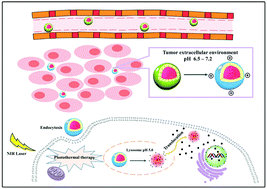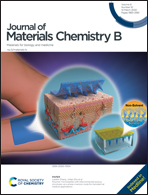A cyanine-based polymeric nanoplatform with microenvironment-driven cascaded responsiveness for imaging-guided chemo-photothermal combination anticancer therapy†
Abstract
Finding out how to overcome multistage biological barriers for nanocarriers in cancer therapy to obtain highly precise drug delivery is still a challenge. Herein, we prepared a multistage and cascaded switchable polymeric nanovehicle, self-assembled from polyethylene glycol grafted amphiphilic copolymer containing hydrophobic poly(ortho ester) and hydrophilic ethylenediamine-modified poly(glycidyl methacrylate) (PEG-g-p(GEDA-co-DMDEA)) for imaging-guided chemo-photothermal combination anticancer therapy. Notably, a novel ATRP initiator containing cyanine dye was designed and attached to the polymer, providing the nanovehicle with NIR-light induced photothermal and fluorescent properties. The PEG shell displayed tumor-microenvironment-induced detachment, resulting in the surface charge change of the nanovehicle from neutral to positive and thus enhancing cellular uptake. Subsequently, the hydrophobic pDMDEA hydrolyzed into a hydrophilic segment in the acidic lysosome, leading to sufficient drug release. Finally, with the aid of the photothermal property, the therapeutic drug DOX successfully escaped from the lysosome to exert chemotherapy. This well-defined polymeric nanoplatform promoted the development of designing novel theranostic polymeric nanovehicles for precise cancer therapy.



 Please wait while we load your content...
Please wait while we load your content...